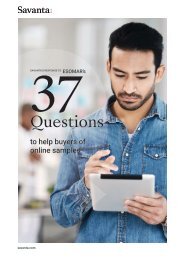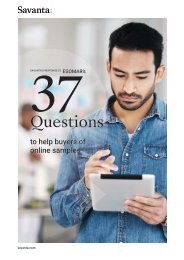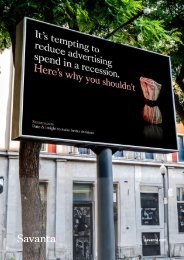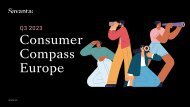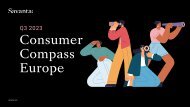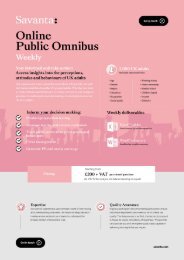Savanta DEI report 2023 v0
You also want an ePaper? Increase the reach of your titles
YUMPU automatically turns print PDFs into web optimized ePapers that Google loves.
DIVERSITY, EQUITY, AND INCLUSION REPORT <strong>2023</strong><br />
Is mainstream media stoking the fire?<br />
The mainstream media, comprising national and regional newspapers, magazines,<br />
TV, movies, podcasts, radio broadcasts, and online publications, is becoming<br />
increasingly fragmented.<br />
With more channels and more publications, it is increasingly difficult to control and<br />
regulate against racist and other harmful content, particularly when trying to balance<br />
online safety with preserving freedom of speech.<br />
The role of algorithms<br />
Whatever consumers’ interests or beliefs, their experiences with online mainstream<br />
and social media are largely controlled by algorithms. Engagement with one piece of<br />
content will result in recommendations for other similar or linked content, which can<br />
result in people ‘going down a rabbit hole’ or being ‘trapped in an echo chamber’.<br />
While many organizations are working to reduce conscious and unconscious bias<br />
in their algorithms, and reduce potentially harmful content from their platforms, the<br />
volume of content means that companies often rely on AI or algorithms to identify<br />
dangerous or inappropriate content, and a lot flies under the radar.<br />
CASE STUDY:<br />
Media Matters for America<br />
Back in 2021, the not-for-profit research and information center<br />
Media Matters for America decided to study TikTok’s algorithm. After<br />
interacting solely with transphobic content, they quickly found that<br />
the recommendation algorithm populated the research account’s ‘For<br />
You’ page with misogynist, racist and white supremacist, antisemitic,<br />
ableist, and other violent or hateful content.<br />
Media Matters for America concluded: “In many videos containing<br />
harmful or violative content expressed more than one form of<br />
dangerous rhetoric… The intersectional nature of these videos means<br />
creators can incorporate various strains of bigotry and hate, and thus<br />
introduce viewers to new, dangerous ideologies.”<br />
53 %<br />
Of people feel that mainstream<br />
media has played an extremely<br />
or very significant role in<br />
perceptions of racism. In the<br />
US, this increases to 62%.<br />
4 %<br />
Agree that the media has played<br />
no role in perceptions of racism.<br />
OPINION:<br />
Kelsie Schroder, Research Manager<br />
As social media has become an integral part of our lives, it’s often<br />
debated how positive screen time is, how credible facts the media<br />
shares are, and the role the media plays in perpetuating negative<br />
perceptions of social issues. But as an avid social media user, I find<br />
power in gaining new perspectives and often learning something<br />
new from real people’s stories. There is no limit to growing our<br />
knowledge as humans, and social media serves as a more informal<br />
way of learning through others’ experiences and stories – opening<br />
me up from my physical bubble.<br />
// 11








